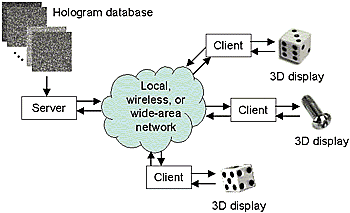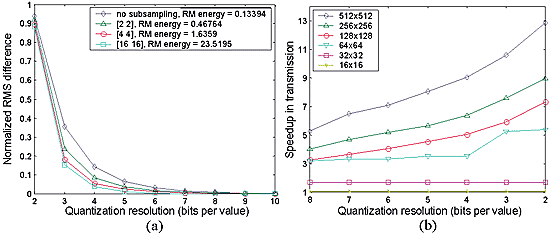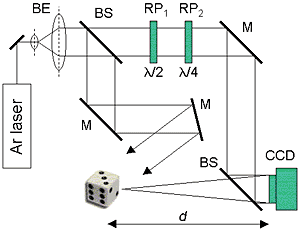| Abstract
We compress phase-shift digital holograms (whole
Fresnel fields) for the transmission of three-dimensional images. For
real-time networking applications, the time required to compress can
be as critical as compression rate. We achieve lossy compression through
quantization of both the real and imaginary streams, followed by a bit
packing operation. We define a speedup metric that combines space gains
due to compression with temporal overheads due to the compression routine
and transmission serialization. We empirically verify transmission speedup
due to compression, using a special-purpose Internet-based networking
application.
Introduction
Digital holography [1-3] is one of several possible techniques for three-dimensional
(3D) imaging. Many existing 3D imaging and processing techniques are
based on the explicit combination of several 2D perspectives (or light
stripes, etc.) through digital image processing. Multiple perspectives
of a 3D object can be combined optically, in parallel, and stored together
as a single complex-valued digital hologram. Digital holography has
seen renewed interest with the recent development of megapixel digital
sensors with high spatial resolution and dynamic range. Their digital
nature means that these holograms are in a suitable form for processing
or transmission. We record in-line digital holograms using a technique
called phase-shift interferometry [3] (PSI), and introduce a third step,
that of digital compression and decompression. Each digital hologram
encodes multiple views of the object from a small range of angles. Different
perspectives of the object can be reconstructed by extracting appropriate
regions from the field and applying a numerical propagation technique
[3,4].
Our digital holograms have dimensions 2028 X 2044
pixels and in their native format store 8 bytes of amplitude information
and 8 bytes of phase information for each pixel. We would like to compress
these fields for more efficient storage and transmission. Compression
of digital holograms differs to image compression principally because
our fields store 3D information in complex-valued pixels, and secondly
because of the inherent speckle content which gives them a white-noise
appearance. It is not a straightforward procedure to remove the holographic
speckle because it actually carries 3D information. The noisy appearance
of digital holograms causes lossless data compression techniques (such
as Lempel-Ziv-Welch, Huffman, and Burrows-Wheeler) to perform poorly.
The use of lossy compression techniques seems essential.
In this article, we apply quantization directly to
the complex-valued pixels. We apply a two-stage compression technique
based on complex-domain quantization and bit packing. This introduces
a third reason why compression of digital holograms differs to compression
of digital images; a change locally in a digital hologram will, in theory,
affect the whole reconstructed object. We are not interested in how
compression noise affects the decompressed digital hologram itself,
only how compression noise affects subsequent object reconstruction.
In this paper, we use a reconstructed-object-plane RMS metric to quantify
the quality of our decompressed digital holograms.
Phase-Shift Digital Holography
We record digital holograms with an optical system [4,5] based on a
Mach-Zehnder interferometer (see Fig. 1). The object beam illuminates
a reference object placed at a distance of approximately d =350 mm from
a 10-bit 2028 X 2044 pixel Kodak Megaplus CCD camera. Through permutation
of the fast and slow axes of the phase retardation plates, RP1
and RP2, we can achieve phase shifts of 0, -p/2, -p, and
-3p/2. The reference beam combines with the light diffracted from the
object and forms an interference pattern in the plane of the camera.
At each of the four phase shifts we record an interferogram. We use
these four real-valued images to compute the camera-plane complex field
by PSI [3]. We call the complex Fresnel field in the camera plane a
digital hologram, given a generalized definition of the term hologram.
|
Fig.
1. Experimental setup for PSI: BE, beam expander; BS, beam splitter;
RP, retardation plate; M, mirror. |
Compression and Network Transmission
Compression will permit digital holograms to be stored more efficiently.
In terms of their transmission, however, there is at least one other
property that should be evaluated when comparing compression strategies.
We need to know the time it takes, relative to the transmission time,
to compress and uncompress the field in order to decide on a compression
mechanism for transmission. In particular, it might not even be advantageous
to compress the data prior to transmission if the latency caused by
the compression routine is significant relative to the average uncompressed
transmission time. We consider the case where it is not possible to
compress the data in advance, for example in a real-time imaging and
transmission application.
In our experiments, the digital hologram window was
compressed by the server using a two-step process. The field data was
first quantized at a particular resolution. Each pixel of the field
data required two data values (real, imaginary). Quantization levels
were chosen to be symmetrical about zero; as a result b bits encode
(2b-1) levels. For example, two bits encode levels {-1,0,1}, three bits
encode levels {-1,-2/3,-1/3,0,1/3,2/3,1}, and so on. The actual data
reduction was performed in the second step, where the appropriate b
bits were extracted from each quantized real and imaginary value, accumulated
in a bit buffer, and packed into bytes.
We quantify the effectiveness of our compression technique
in terms of both space and time resource usage by using a measure called
speedup. Speedup s is defined as s = Pu / Pc
where Pu is the time required to process and
transmit the uncompressed digital hologram and Pc
is the time required to process, compress, transmit, and decompress
the digital hologram. Our timing data is obtained using a special-purpose
freely-accessible Internet application that, through the integration
of compression and transmission routines into a single application,
was able to measure reliably and accurately the interaction between
compression times and transmission times.
 |
Fig.
2. Illustration of the network-independent multiple-client system.
|
Experiments
To determine the quality of the compressed reconstruction we compare
it with a reconstruction from an uncompressed digital hologram using
a normalized rms (NRMS) difference criterion. A plot of NRMS error against
lossy compression through quantization of complex-valued digital hologram
data is shown in Fig. 3(a). Quantization at 4 bits results in a compression
rate of 16, for low NRMS errors of less than 0.06 in the reconstructed
object intensity (with 4 X 4 pixel subsampling). Next we performed the
speedup experiments. For several degrees of quantization, and several
digital hologram window sizes, a client made requests to the Internet
application’s server. Forty trials were recorded for each quantization
and each window size. A plot of speedup against compression, for several
window sizes, is shown in Fig. 3(b). Incorporating the compression/decompression
delays into the transmission timings we observed a speedup of over 9
for window sizes of 512 X 512 pixels and greater. For windows of size
64 X 64 pixels, or greater, there is still significant speedup (over
2.5) for quantizations of 8 bits or lower. Our Internet-based compression
application and full timing results are accessible online at http://hologram.cs.may.ie/online/jao2003/hologram.html.
 |
Fig.
3(a) NRMS difference in the reconstructed intensity plotted against
number of bits in each of the digital hologram's real and imaginary
values, for various degrees of subsampling. (b) Speedup as a function
of increasing compression, for various digital hologram window
sizes. |
Conclusion
Digital hologram compression results undeniably make a case for applying
compression strategies to the storage of digital holograms. However,
in order to be useful for a real-time 3D object capture, transmission,
and reconstruction system, the compression strategies must be shown
to admit efficient algorithms that make it advantageous to spend time
compressing and decompressing rather than simply transmitting the original
data. We have defined a speedup metric that combines gains and losses,
in both space and time, due to compression and believe that all compression
algorithms for real-time or time-critical applications could be evaluated
in this way. Our compression technique is based on quantization of real
and imaginary components followed by a bit packing operation. The algorithm
is efficient (linear in both space and time with respect to the number
of holographic pixels) and has been ported for experimentation to a
special-purpose Internet-based digital hologram compression application.
Acknowledgement
The authors wish to thank Yann Frauel and Enrique Tajahuerce for the
use of their digital hologram data.
References
[1] J.W. Goodman and R.W. Lawrence, Appl. Phys.
Lett. 11, pp. 77-79 (1967)
[2] M.A. Kronrod, et al., Sov. Phys. Tech. Phys.
17, pp. 414-418 (1972)
[3] I. Yamaguchi and T. Zhang, Opt. Lett. 22, pp.
1268-1270 (1997)
[4] B. Javidi and E. Tajahuerce, Opt. Lett. 25,
pp. 610-612 (2000)
[5] Y. Frauel, et al., Appl. Opt. 40, pp. 3887-3893
(2001)
[6] T.J. Naughton, et al., Appl. Opt. 42, pp. 4758-4764
(2003)
(1) Department of Computer Science, National University
of Ireland, Maynooth, County Kildare, Ireland. Email: tom.naughton@may.ie;
johnmcd@cs.may.ie
(2) Department of Electrical and Computer Engineering,
University of Connecticut, U-157, Storrs, CT 06269, USA. Email: bahram@engr.uconn.edu
If you would like to contact the IEEE
Webmaster
© Copyright 2004, IEEE. Terms
& Conditions. Privacy
& Security

|


